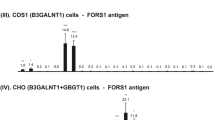Abstract
Red cell Lewis antigens are carried by glycosphingolipids passively absorbed from plasma. Plasma was collected from a spectrum of individuals with normal and unusual Lewis/secretor phenotypes in order to investigate the glycolipid basis for the unusual phenotypes. Samples were obtained from: a Le(a+b−) ABH nonsecretor who secreted Lewis substances; a Le(a+b−) partial secretor; Le(a+b+) partial secretors; Le(a+b+) secretors; and a full range of normal Lewis/secretor phenotypes as controls. The Le(a+b+) samples represented Polynesian, Asian and Réunion Island ethnic backgrounds. Nonacid glycolipids were prepared, separated by thin-layer chromatography, and then immunostained with potent monoclonal antibodies of known specificity. Despite different serological profiles of the Le(a+b−) and Le(a+b+) Polynesian samples, their plasma glycolipid expressions were very similar, with both Lea and Leb co-expressed. The copresence of Lea and Leb in Le(a+b+) samples is in marked contrast to Caucasians with normal Lewis phenotypes, who have predominantly either Lea or Leb. These results suggest that there is a range of the secretor transferases in different individuals, possibly due to different penetrance or to several weak variants. We also show that Lewis epitopes on longer and/or more complex core chains appear to be predominant in the Polynesian Le(a+b+) samples. The formation of these extended glycolipids is compatible with the concept that in the presence of reduced secretor fucosyltransferase activity, increased elongation of the precursor chain occurs, which supports the postulate that fucosylation of the precursor prevents or at least markedly reduces chain elongation.
Similar content being viewed by others
Abbreviations
- CBA:
-
chromatogram binding assay
- TLC:
-
thin-layer chromatography
References
Oriol R, Le Pendu J, Mollicone R (1986)Vox Sang 51: 161–71.
Clausen H, Hakomori S (1989)Vox Sang 56:1–20.
Mourant AE (1946)Nature 158:237–8.
Andresen PH (1948)Acta Path Microbiol Scand 25:728.
Marcus DM, Cass LE (1969)Science 164:553–55.
Oriol R, Danilovs J, Lemieux R, Terasaki P, Bernoco D (1980)Hum Immunol 3:195–205.
Dunstan RA, Marcus B, Simpson MD, Rosse WF (1985)Am J Clin Pathol 83:90–94.
Grubb R (1948)Nature 162:933.
Brendemoen OJ (1950)J Med Clin 36:335–41.
Race RR, Sanger R (1975) InBlood Groups in Man, 6th ed.: pp. 311–22. Oxford: Blackwell Scientific Publications.
Henry SM, Simpson LA, Woodfield DG (1988)Hum Hered 38:111–16.
Henry SM, Simpson LA, Benny AG, Woodfield DG (1989)NZ J Med Lab Technol 43:64–67.
Henry SM, Dent AM, Harding Y (1990) InProceedings of the second international workshop and symposium on monoclonal antibodies against human red blood cells and related antigens. Lund, p. 75.
Henry SM, Benny AG, Woodfield DG (1990)Vox Sang 58:61–66.
Henry SM, Woodfield DG, Samuelsson BE, Oriol R (1993)Vox Sang 65:62–69.
Vos GH, Comley P (1967)Acta Genet 17:495–510.
Sturgeon P, Arcilla MB (1970)Vox Sang 18:301–22.
Lin-Chu M, Broadberry RE, Chang FJ (1988)Transfusion 28:350–52.
Ventura M, Gibaud A, Le Pendu J, Hillaire D, Gérard G, Vitrac D, Oriol R (1988)Hum Hered 38:36–43.
Karlsson KA (1987)Methods Enzymol 138:212–20.
Magnani JL, Smith DF, Ginsburg V (1981)Anal Biochem 109:399–402.
Hansson GC, Karlsson KA, Larson G, Samuelsson BE, Thurin J, Bjursten LM (1985)J Immunol Methods 83:37–42.
Good AH, Yau O, Lamontagne LR, Oriol R (1992)Vox Sang 62:180–89.
Henry SM, Oriol R, Samuelsson BE (1994)Vox Sang (in press).
Mourant AE, Kopec A, Domaniewska-Sobczak K (1976) InThe Distribution of the Human Blood Groups and Other Polymorphisms, 2nd ed.: pp. 548–76. Oxford: Oxford University Press.
Lin-Chu M, Broadberry RE (1990) InProceedings of the second international workshop and symposium on monoclonal antibodies against human red blood cells and related antigens. Lund: p. 79.
Henry SM, Samuelsson B, Oriol R (1994)Glycoconjugate J 11:600–7.
Stroud MR, Levery SB, Nudelman ED, Salyan MEK, Towell JA, Roberts CE, Watanabe M, Hakomori S (1991)J Biol Chem 266:8439–46.
Stroud MR, Levery SB, Salyan MEK, Roberts CE, Hakomori S (1992)Eur J Biochem 203:577–86.
Watanabe M, Ohishi T, Kuzuoka M, Nudelman ED, Stroud MR, Kubota T, Kodaira S, Abe O, Hirohashi S, Shimosata Y, Hakomori S (1991)Cancer Res 51:2199–204.
Author information
Authors and Affiliations
Rights and permissions
About this article
Cite this article
Henry, S.M., Oriol, R. & Samuelsson, B.E. Expression of Lewis histo-blood group glycolipids in the plasma of individuals of Le(a+b+) and partial secretor phenotypes. Glycoconjugate J 11, 593–599 (1994). https://doi.org/10.1007/BF00731311
Received:
Revised:
Issue Date:
DOI: https://doi.org/10.1007/BF00731311



